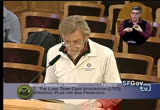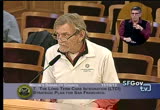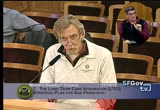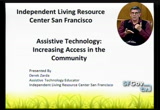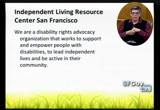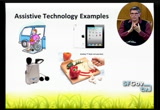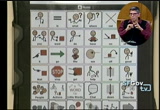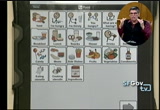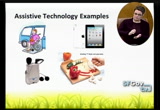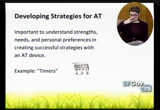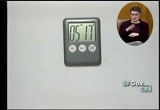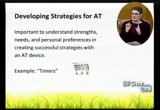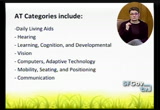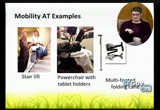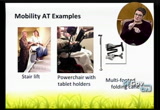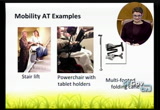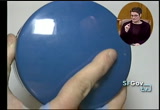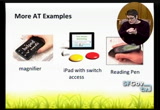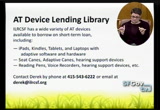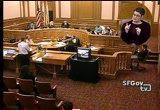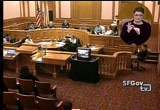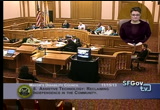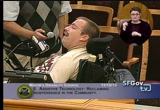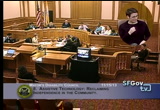tv [untitled] November 26, 2013 1:30am-2:01am PST
1:30 am
agenda item number 9 today will be a discussion from the dph about community integration i want you to know -- that dcip doesn't mean diversion and i will be testifying regarding how many long-term care patients are being diverted or dumped out of county and not into community reintegration efforts and i'm going to give you an example of a gentleman who fell off a bar stool would wound up at sfgh attempted to get him transferred to laguna honda and the excuse of not transferring him there was because he needed too much physical therapy and so instead of keeping this gentleman in
1:31 am
san francisco, he was dumped into a facility in ant i ioch that serves people with dementias and alzheimer's and he had no one to talk to because the roommates and building occupants were all too demented and i believe he was i yanked out of state. this counsel needs to closely monitor this item to find out whether san francisco is doing what we accuse nevada does simply patient dumping and calling it community reintegration. thank you.
1:32 am
1:33 am
obama care and a lot of people don't understand why they need obama care of a president in washington, d.c. i don't know if you know about this or not, but i wanted you to respond about the plan and if you know anything about the plan that obama have called obama care. thank you. >> did you wish to respond to that, mr. haskell? >> okay. >> any other public comment in ? all right then. thank you. moving on to agenda item number 8 which is assistive technology reclaiming independence in the community and the presentation will be given but councilmember
1:35 am
go ahead and put on the powerpoint presentation at the very beginning that would be fine. thank you. >> good afternoon counsel. my name is derek zarda i'm also besides being a councilmember an assistive technology coordinate at the center for independent living in san francisco i'm here to talk to you about assistive technology what it is and its role. but first i'd like to talk a little bit about what our center is
1:36 am
about. so independent living resource center of san francisco, we are a disability rights advocacy organization that works to support and empower people with disabilities in leading independent lives and being active in their community and we champion the independent living philosophy. that the person with the disability takes the lead role advertise identifies what their needs are and creating steps to achieve those goals. i'm really proud that we have ninety percent myself included and just real quick i'll go over some of the
1:37 am
programs that we offer. we have counselors that are versed in a variety of backgrounds including housing advocacy and tenants right benefits and employment transportation assistive technology information and referral and peer support and advocacy. not just advocating on behalf of the consumer but also working with them to instill their own self advocate skills in building that up within them and in the display i have a photo of our resource room which offers materials in all these different areas it's updated weekly or every other two weeks and also includes information in english chinese and spanish. >> so what is assistive technology? assistive
1:38 am
technology refers, or at refers to any tool or device that allows a person greater independence in daily life it's an essential part of our lives to ensure equal access of people of all abilities so it's something we use daily whether we know it or not whether we're checking a text message on our phones or looking at a map with gpa these can all help us in our daily lives. real quick i thought i'd put up some examples. so we have in the top left corner clip art i love clip art, of a woman who's using a wheelchair that has an adaptable ramp mechanic al ramp
1:39 am
that folds out and this ramp can also as the driver herself so she can drive the car herself and be allowed greater independence in her community. i have an ipad to kind of showcase what it means whether when you have technology that's becoming more interactive such as tablets real quick i'm going to go ahead and put on one app today from an ipad -- thank you so much so we have here an application called proloquo to go thank you again to the asl interpreters to help me out i'm
1:40 am
speaking fast i'll try to slow down. so basically we have a communication board that's been is shown here kind of virtual ly which allows a person with a cognitive ability the independence to communicate their needs better and this one here offers customizable options so not just pushing in -- i have i should have probably prepared one that's more advanced. you can say i'm hungry i want to read a book i want this, i need to go here, you can insert your own custom word and see when you grant this type of access to students to adults with disabilities you can see firsthand their ability to communicate and gain greater independence in advocating for their own needs and access in the community and so forth. thank you back to the slide
1:41 am
show please control room. thank you. in the bottom left corner we have a hearing after the uxiliary device basically allows a person who has a hard of hearing or hearing loss to have an amplified sound with a mic in the front that fits in the palm of their hand, easy to use and they can better get access. lastly, we have in the bottom right corner an adaptable cutting knife for the kitchen known as a rocking knife something that can be gripped by the hand for a person who may have difficulty gripping or holding a kitchen knife to be able to still have access in the kitchen for preparing food. there's
1:42 am
devices similar to this such as talking scales talking timers to address a variety of needs. >> but the most important thing today that if there's anything you take away from this, it's that it's not just about the device, it's not about finding an ipad and tossing it to them and saying here go be successful. it's about understanding that person's needs and strengths. that's why developing strategies for using this technology is a key component in my work. as an example, take off the ipad and i can get the control room to put on the over head again one more time. thank you. is shown here is a palm sized timer. it is it has a display
1:43 am
screen and 3 buttons for minutes seconds, start and stop and it costs a dollar. for me as a person with moderate adhd i know my strengths and i know my needs and what works for me and what doesn't so with this device -- if i could hut hit the over head one more time. i know that over the course of a few minutes depending on how i feel that day my attention to details can be minimal so i can set this timer for five minutes if i'm having a good day. 3 minutes if it's a so-so day 2 minutes if it's a fantastic day. put in my pocket go back to my work then the timer will
1:44 am
go off and no matter what i'm doing i'll be called back -- am i working on what i'm supposed to be working on. why am i paying attention to this e-mail when i have so many to deal with. i don't want to use my phone for this. it's a smartphone it will have apps and so many distractions that there's no way i can could ncentrate so one device it costs a dollar, easy, it keeps me on track. if i lose this device, it's just a dollar but that's just a point to illustrate what at is and what it can be. you don't have to go out and buy an ipad or the most expensive product but you have to have a good understanding of what it
1:45 am
really means to try to meet your needs and the best part is you don't have to know all this technology. you don't. it's changing every day it's vast and expansive. so what helps as long as they know what their needs and strengths are, you can go from there. and a few more slides we'll go over some of the categories that they have can include daily living aids like you saw with the rocky knife and hearing and learning cognition and developmental that we saw with the ipad app and vision for people with low vision and for people that are blind they might have systems that talk aloud or a screen reading program. we have computers and adaptive technologies which is
1:46 am
possibly a head mouse used for putting a censor on the forehead to be used as a mouse for access to the computer screen. mobility and seating and positioning all 3 very important components. also includes other types of adaptations and lastly communication. >> on this next slide i have featured a few pictures on the far left is a picture of a couple inside the home and the man and a woman and the woman is using a stair lift. basically stair lifts is a device that allows a person increased access inside or outside their home along a set of stairs involves a low railing and then a chair which
1:47 am
traverses along the path letting the person go up and down a set of stairs. why is this important? there are many many people in san francisco that have to deal with on a daily basis as you heard er early er we have old houses houses that are always going to be on hills and including a set of stairs before you even get to the first floor one of the calls i get the most is about stair lifts and the availability of having the financial resources to access them. it is not covered under medical or medicare to some degree it is if the providers want to work with them but it's still not enough to be able to allow or grant enough access so that's an issue i think can be explored more as far as the vendors their availability to have it covered through medical
1:48 am
and also working to see about trying to diversify to make it more accessible. second in the picture in the middle i have a picture of one of our co-workers peter mendoza who's using his electric power chair but more importantly he has a setup of 2 smart tablets being held up in front of him by a coil type of clamp. hey peter, thank you. [laughter]. >> for those who are here peter is approaching and he's showing off his setup system. by having these thin but sturdy clamps he's able to access his smart devices really important for getting around the city when at work for checking
1:49 am
e-mails basically being able to increase his capacity to work and access the community. thank you peter. lastly on the right i have a picture of a hurricane -- spelled hurrycane that is able to it's a multifooted folding cane so 4 feet at the bottom instead of one and stands on its own and folds up in this city where we have a lot of hills this is something that i also get a lot of requests for from seniors and younger adults with disabilities because it helps them go on uneven surfaces much easier and also when they go on to muni they can fold it up so it's not being hit by people and they are not losing it so again, trying to find things that better fit the person and their needs. i have a few more. we have just a few more
1:50 am
photos on the left and this slide we have an electronic magnifier which enhances the text for a person reading print. we have in the middle an ipad again but this is showcasing looks to be two large m and m's those in fact were referred to as switch buttons these and i brought a few today -- are for those who might have difficulty in having access through using their hands or through other means so on the projector please -- thank you so much. we have what looks like like i said -- it's in it's in fact a large button can be used with the elbow or knee or foot and it can be used with a variety of
1:51 am
tools can be hooked up to an ipad alarm clock you put 2 of these together -- here we have a blue tooth connection with two buttons to navigate the ipad again increasing access through a variety of creative means and finally on the right a person using a big fat marker electronic device that's a reading pin that provides a person the ability to scan text and see it pop up on a small screen being able to have that word spoken aloud and the definition of what the word is, is used a lot in the disability community. so lastly to learn
1:52 am
more about at as well as local organizations here in the bay area and in san francisco especially, and last slide i want to talk about our at device library program at independent resource living center in which we offer people the opportunity to tryout a device of one of the many we have available for up to 30-day and see in this way they can check out stuff such as an ipad kindle laptops which allows a person to talk then types a reading pen voice recorders and so forth. for those who are interested, they can contact me by phone at 415-543-6222 or e-mail at derek at ilrcsf dot
1:53 am
1:54 am
remote to turn on and off your lamps and i actually got it at walgreen's and i think it's less than 12 dollars so i think little gadgets will make a big difference to be able to you know be more independent and you can actually use something like a remote and it's pretty simple and the second thing i'd like to add, the programs at irlc, in addition to all the programs that irlc san francisco offers, is community activities and i'm the coordinator for the program and so i give out flyers on the table announcing events, so
1:55 am
besides just the program and as mentioned services that we have, we also have fun activities so if you would like to contact me, please do. thank you. >> thank you. any other councilmember comments or questions? >> derek, thank you very much for your presentation. i just want to comment on the fact that those buttons are the coolest thing i've seen had no idea they existed. that's great. thank you. >> okay we have public comment from mr. shaw. >> okay then jerry grace. >> derek, one thing i just
1:56 am
thought about this, very important to me, everything you had on there is a great idea. only one thing you left out -- i never thought about this -- people that can't see or can see a little bit but my friend sara is a very good person and she do a lot of different things. she has one bad arm and one good arm, and she can see a whole lot but can't go out at night and only in the day time go out there do what she need to do get back before it get dark. so what i'm trying to say is she can she
1:57 am
can't see very well but everything you had on there is great i love it. a some of the people it's hard for me to explain it, but in the picture -- thank you. >> thank you. >> thank you for your comment. if your friend is interested, she can contact our agency and we can work with her to find adaptable solutions to fit her needs. >> any other public comment? >> good afternoon
1:58 am
councilmembers. i work with the ilrc up in san francisco. i was speaking to recognize the crew of the fire truck company number one that came to my aid when i was stuck on a golden gate bus yesterday because the lift wouldn't work so the fire fighters had to take me from my chair, put me on a seat and then take my chair down and then bring me down to put me in my chair they also had to adjust my clothing because with all that movement, things get moved around. it really required a lot of good communication because i am not easy to move so i just want to recognize them and i just want to say thanks and one of the
1:59 am
reasons i'm bringing it before this body is i know that both the counsel and the mayor's office on disability has done a lot of training around these types of issues and so i want to say that your training really works. thank you very much. >> thank you. any further public comment on derek's presentation? okay. let's move on to agenda item number 9. oh, car la? >> yes to the chair our speaker for agenda item 9 is not here just yet. she is expected momentarily. you might choose to go to agenda item 10 while we wait. >> i will take that suggestion. let's move on to agenda item number 10. we'll get back to number 9. this is a report from the physical access committee.
2:00 am
>> hello councilmembers i'm john paul scott. i'm making the presentation today for counsel person wong to help him save his voice. we have two meetings that we want to report on and get into the record. we had a meeting on friday october 11th of th year at 1: 30 to 3: 30 p.m. old business was a presentation by me on the status of our ada transition plan what projects had been completed in construction this recent year what ones under construction and which ones are under designed. i won't go through that list i do that once a year for you all. i have to say we're doing pretty good but
43 Views
IN COLLECTIONS
SFGTV: San Francisco Government Television Television Archive
Television Archive  Television Archive News Search Service
Television Archive News Search Service 
Uploaded by TV Archive on

 Live Music Archive
Live Music Archive Librivox Free Audio
Librivox Free Audio Metropolitan Museum
Metropolitan Museum Cleveland Museum of Art
Cleveland Museum of Art Internet Arcade
Internet Arcade Console Living Room
Console Living Room Books to Borrow
Books to Borrow Open Library
Open Library TV News
TV News Understanding 9/11
Understanding 9/11